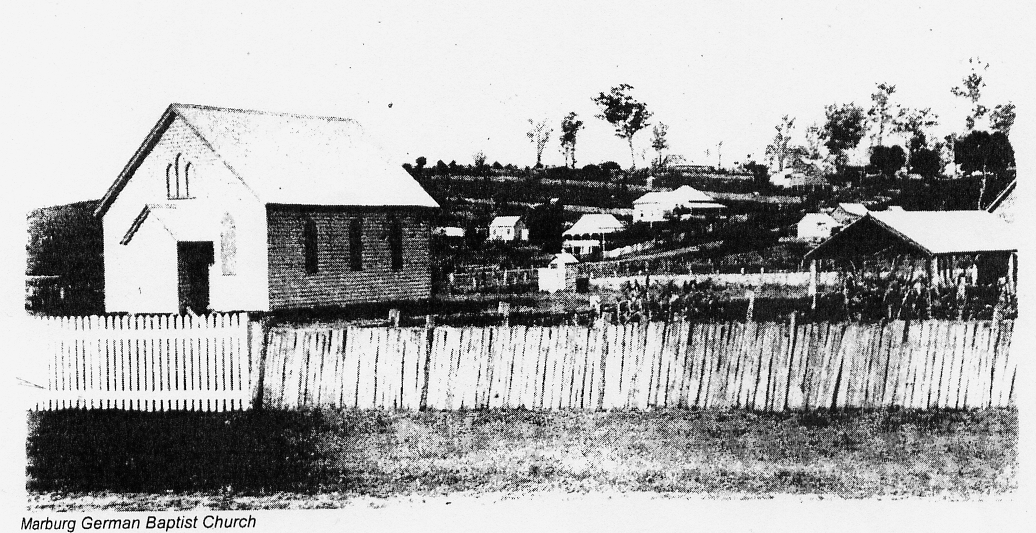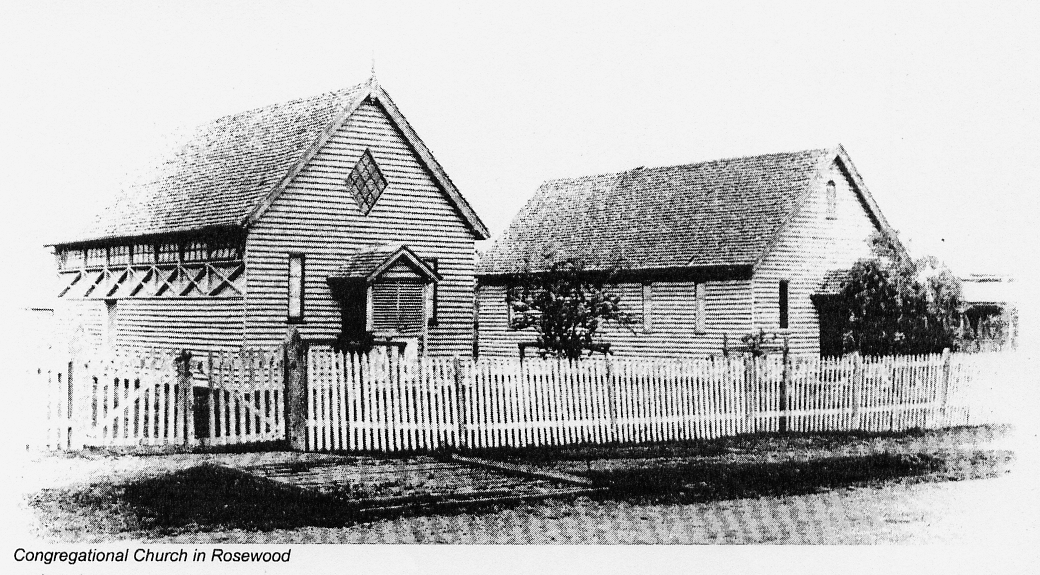Rosewood Scrub churches
The German pioneers were men and women of strong religious conviction.
Although more than ninety percent would describe themselves on arrival
as Lutheran, German names can be found among the congregations of
churches of all faiths today. Plagued from the outset by bitter
quarrels and doctrinal differences Lutheran congregations fragmented to
establish new churches nearby, or families joined Primitive Methodist,
Congregational, Church of Christ, Church of England or
Catholic faiths. The Lutheran Church had been plagued by doctrinal
differences from its inception, and found it
hard to provide pastoral and administrative help to the new arrivals.
But the problems were far more
complex. Pastors recruited from Germany had little or no English and
insisted strenuously on the German
language from the pulpit, in
communion classes and in church records, upsetting a growing number of
new generation members. Harder to
substantiate, but probably true to a degree was the inherent
rugged individualism and stubbornness - the very Qualities that drove
so many to win the battles of the bush on
their selections enabled many devout fundamentalist Lutherans to I more
comfortably in the shoes of
Baptist, Church of Christ or Methodist
preachings and teachings.

(Primitive Methodist church, Tallegalla)
An earlier church was a slab and shingle building near the
present Tallegalla School. In 1881 a new church was
built on a high crest at Tallegalla on land donated by the Freeman
family to include a cemetery as well. It attracted quite a few
German families of that area. The church was replaced, then later
removed to Eumundi; the cemetery which remains on the site is one
of the most attractive rural cemeteries in the State. Early
churches in the Scrub made good use of abundant timber
in-situ to erect small shingled structures on stumps.
The metal stump caps preserved the timber above them from the ravages
of termites, but had a secondary use. After holes had been dug and the
posts rammed, a dedication and fund-raising stump-capping ceremony was
held that invited church members and visiting dignitaries to place
donations for the building in the inverted metal caps.

(harvest festival in same church)
Annual harvest festivals in most churches
reminded congregations of the richness of the soils that
supported them.

(Marburg German Baptist Church)
Taken at the turn of the century. The simple, open shed on
the right is not a forerunner of the modern carport, but a
shelter for worshippers waiting for the service to start. The large
homes in the centre face Edmond Street and stand today.

( St. Johns, Minden / St John's, Coolana. Lutheran churches)
Each building bears its own subtle touch of German heritage: the
imposing tower on St. Johns, Minden. on the left; the pyramidal spire
of St John's, Coolana, on the right.
These two fine Lutheran churches bear no evidence of the
early turmoil that cleaved congregations asunder to cause separate
Lutheran churches to be built close to one another. The old wounds have
long healed, families have been linked by intermarriage and peace and
goodwill prevail. The altercations and splitting of
congregations was by no means confined to the Minden churches. At one
stage Lowood had two Lutheran churches, St Mark's, and Bethel, on
opposite sides of Park Street, poised like two bantam cocks for battle.
It took them forty long, bitter years to sink their differences to
re-unite under the name Trinity Lutheran.

(Interior of the Trinity Lutheran Church, Marburg, tastefully decorated
for the wedding of Elsie Stegemann and Arnold Bachmann. The church was
built and dedicated in 1888.)

(Congregational Church in Rosewood)
The two buildings - the Church and the Sunday School Hall
as they appeared in 1900, the interesting criss-cross pattern along the
wall of the church is repeated in the simple stained glass window. The
two buildings are a fine match. Later they were put together to form a
cross.

(Haigslea (Kirchheim) Methodist / Uniting church)
The Haigslea (Kirchheim) Methodist congregation comprised
many German families: Heiner, Huth, Berlin, Sprenger, Eisenmenger,
Steinhardt, Guth, Berndt, Rohl, Hertweck, Claus, Verrenkamp. Some like
Harry and Minna Steinhardt had been confirmed in the Lutheran faith.
With the forming of the Uniting Church in 1977, the former Wesley
Methodist Church at Haigslea was moved to the site to effect at once a
physical and spiritual union.

(St Brigid's Catholic Church, Rosewood )
This magnificent church is said to be the largest wooden church in
Australia, and few would deny that
it is the most beautiful. From its earliest days it has
had only a relatively small percentage of German people among its
parishioners. No doubt the Rosewood Scrub made a substantial
contribution in other ways; most of the fine timbers used in
construction would have come from the Scrub.
German
settlers were generally Protestant but some from the Rhineland, Nassau,
Bavaria, Baden and Poland were Catholic... Before churches were built
priests travelled
out from Ipswich and said Mass at homes as advertised previously in the
Queensland Times.
Bishop Quinn moved to meet the
special needs of recently migrated German parishioners by inviting a
German priest, Fr. Kaercher. to Queensland in 18 71.... High up
Berlin's Road atop the range at Tallegalla, at the crossroads
just south of Two Tree Hill, Church authorities purchased just over
three acres of land for a church and
cemetery. The site can still be
identified by the remaining grave sites.. ..Besides building St.
Brigid's (Rosewood), and probably building St. Boniface's (as the
Tallegalla Church was known), Lucas Ulrich was later chairman of a
committee that removed the building of St. Boniface's to Marburg in
1901. [Terry Rowden]
A modern church replaced the old St. Boniface's church in Owens Street,
Marburg in June 1993. Three years later the old and neglected cemetery
on the Two Tree Hill site was fenced and marked with a heritage sign by
the Ipswich City Council.
The congregations of other Catholic churches in the Scrub included
higher percentages of German families.
St
Michael's, built on a hillside between Lowood and Tarampa on land
donated by Michael Kluck, was consecrated
in 1888. The church was moved to North Ipswich in 1934 for use as a
school hall. The cemetery is
still in use. St. Brendon's, Lowood, was built at the corner of Church
and Prospect Streets. A new brick church was erected next to the old church in
1980. Glamorgan Vale had several Irish settler families like the
O'Briens. the Kellys and the
Dwyers before the influx of the Germans, when it was known as Bald
Ridges. The church has a
fire-and-brimstone history - physically, not spiritually. The first
church was destroyed by lightning in 1909, the second by fire in 1949. [Fred
Kleidon]
The Baptist Church at Marburg was
predominantly German from its beginnings in 1871. Its membership of 14 comprising mainly the Dahm, Lamprecht and
Arndt families, climbed dramatically to 173 by 1877. The first pastors, Windolfand Bernoth, were German
and services were in German. Serious divisions plagued the church,
that prompted the building of a
second church. In I 9 14 it was linked into a pastorate with Lanefield
and came under the English
influence of the Queensland Baptist Union. [Fred Kleidon]
My grandmother Minna Beduhn (born Schuiz,
1878) told us that as a child she could attend the English speaking or German speaking services at
the Baptist Church. But services were mainly held in German. Saturday morning German School was held somewhere
in the vicinity of the present Church of Christ. [David Beduhn]
[from book in
Rosewood Scrub museum in Marburg]







